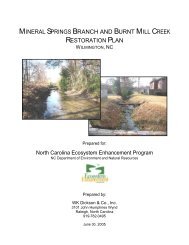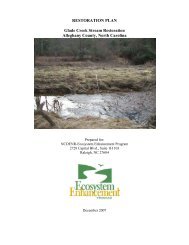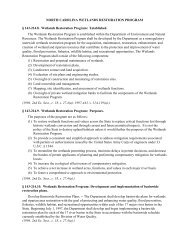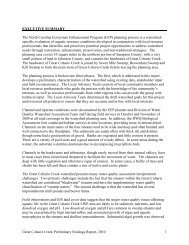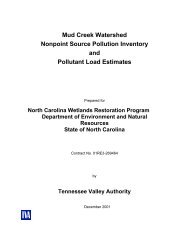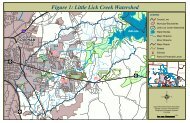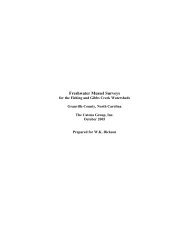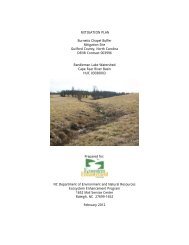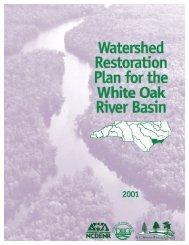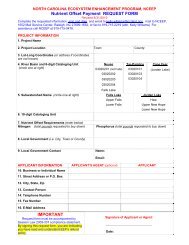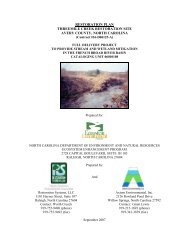Mud Creek Watershed Restoration Plan - Henderson County Center
Mud Creek Watershed Restoration Plan - Henderson County Center
Mud Creek Watershed Restoration Plan - Henderson County Center
Create successful ePaper yourself
Turn your PDF publications into a flip-book with our unique Google optimized e-Paper software.
Bat Fork. The overall goal of the project was to provide the foundation for future water qualityrestoration activities by: 1) identifying the most likely causes of biological impairment (such asdegraded habitat or specific pollutants); 2) identifying the major watershed activities and sourcesof pollution contributing to those causes (such as stormwater runoff from particular urban orrural areas, streambank erosion, or hydrologic modification); 3) outlining a watershed strategythat recommends restoration activities and best management practices (BMPs) to address theseproblems and improve the biological condition of the impaired streams.As part of this study, DWQ conducted extensive biological assessments in the <strong>Mud</strong> <strong>Creek</strong>watershed, sampled ambient and storm water quality and walked many miles of streams in thewatershed to assess stream habitat, morphology, and riparian zone condition. The study alsoevaluated watershed hydrologic conditions, land use, land management activities, and potentialpollution sources. WARP staff, located in Asheville, participated in <strong>Mud</strong> <strong>Creek</strong> Councilmeetings and worked closely with local resource management professionals to draw on theconcerns and experience of watershed residents, local governments and others in evaluating thenature of water quality problems and outlining potential solutions. Once complete, theassessment report describing conclusions on these issues will be available to the CWMTF,watershed stakeholders, and other interested parties through the DWQ website. Preliminary datafrom this report are summarized in Section 2.1.4 NC Wetlands <strong>Restoration</strong> Program Local <strong>Watershed</strong> <strong>Plan</strong>ningIn 2000, the NCWRP initiated a Local <strong>Watershed</strong> <strong>Plan</strong>ning program to conduct detailedrestoration planning in a limited number of Targeted Local <strong>Watershed</strong>s across the state. Theselocally-based plans include a comprehensive watershed assessment to identify causes andsources of nonpoint source impairment. The NCWRP will use these plans to identify wetlandand stream restoration projects to meet projected Department of Transportation compensatorymitigation requirements. Through this process, the NCWRP will work with local stakeholders toidentify and prioritize wetlands areas, stream reaches, riparian buffer areas and bestmanagement practices that will provide significant water quality improvement and otherenvironmental benefits to local watersheds. The NCWRP coordinates with local communitygroups, local governments, and others to develop and implement these plans. The NCWRPinitiated the local watershed planning process in the <strong>Mud</strong> <strong>Creek</strong> watershed to complement theefforts underway by the DWQ and <strong>Mud</strong> <strong>Creek</strong> <strong>Watershed</strong> <strong>Restoration</strong> Council.1.5 Tennessee Valley Authority Integrated Pollutant Source IdentificationIn 2000, the Tennessee Valley Authority developed a set of Integrated Pollutant SourceIdentification (IPSI) tools to help DWQ, the NCWRP and the <strong>Mud</strong> <strong>Creek</strong> <strong>Watershed</strong> Councilidentify and prioritize water quality improvement and protection measures in the <strong>Mud</strong> <strong>Creek</strong>watershed. The IPSI consists of a geographical database of watershed features such as landcover, estimates of impervious land cover, streams, soils, slope, and information about potentialnonpoint sources of pollution including streambank erosion sites, livestock operations, andunpaved roads. The TVA IPSI data and methods are summarized in the report <strong>Mud</strong> <strong>Creek</strong><strong>Watershed</strong> Nonpoint Source Pollution Inventory and Pollutant Load Estimates (TVA,2001). A subset of the TVA IPSI data are summarized in Section 2. The complete reportsummarizing the IPSI data for the <strong>Mud</strong> <strong>Creek</strong> watershed is available athttp://h2o.enr.state.nc.us/wrp/pdf/lwp/mud_creek_lwp_ipsi.pdf.Section 1: Project Overview Page 3




